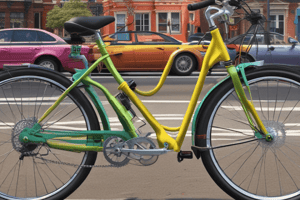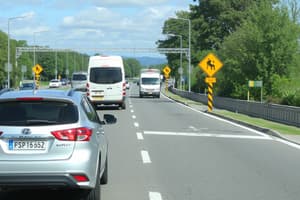Podcast
Questions and Answers
Explain how the two-second rule helps maintain a safe following distance. What conditions might require increasing this distance?
Explain how the two-second rule helps maintain a safe following distance. What conditions might require increasing this distance?
The two-second rule provides a minimum following distance, allowing time to react and stop safely. Adverse weather, poor visibility, or following large vehicles necessitate increasing this distance.
A car slows for a pedestrian crossing. Are you legally allowed to pass?
A car slows for a pedestrian crossing. Are you legally allowed to pass?
No, you are not allowed to pass.
You're behind a slow vehicle on a road with no lane markings and good visibility. Can you legally pass?
You're behind a slow vehicle on a road with no lane markings and good visibility. Can you legally pass?
Yes, you are allowed to pass.
You're following a car on a road with 'no passing' lines (double yellow lines). Are you allowed to pass?
You're following a car on a road with 'no passing' lines (double yellow lines). Are you allowed to pass?
Why is it important to be aware of traffic laws even when driving on roads with seemingly little to no other traffic?
Why is it important to be aware of traffic laws even when driving on roads with seemingly little to no other traffic?
You're behind a car in the same lane approaching an intersection. Can you pass?
You're behind a car in the same lane approaching an intersection. Can you pass?
You're following a car on an unlaned road approaching an intersection. Can you pass?
You're following a car on an unlaned road approaching an intersection. Can you pass?
Explain how understanding traffic law contributes to anticipating the actions of other drivers and pedestrians.
Explain how understanding traffic law contributes to anticipating the actions of other drivers and pedestrians.
Describe a scenario where a driver's misunderstanding of right-of-way rules could lead to a dangerous situation. How could knowledge of the law prevent this?
Describe a scenario where a driver's misunderstanding of right-of-way rules could lead to a dangerous situation. How could knowledge of the law prevent this?
The car ahead on an unlaned road signals a right turn. Can you pass on the left?
The car ahead on an unlaned road signals a right turn. Can you pass on the left?
Explain the potential dangers of passing another vehicle at an intersection, even if there are no explicit 'no passing' markings.
Explain the potential dangers of passing another vehicle at an intersection, even if there are no explicit 'no passing' markings.
How does knowledge of traffic regulations impact a driver's ability to safely navigate changing weather conditions such as heavy rain or fog?
How does knowledge of traffic regulations impact a driver's ability to safely navigate changing weather conditions such as heavy rain or fog?
Explain how familiarity with traffic laws regarding vehicle maintenance requirements (e.g., working headlights, proper tire tread) contributes to overall road safety for all users.
Explain how familiarity with traffic laws regarding vehicle maintenance requirements (e.g., working headlights, proper tire tread) contributes to overall road safety for all users.
A driver approaches an intersection where the traffic lights are flashing yellow. What legal requirement must the driver adhere to?
A driver approaches an intersection where the traffic lights are flashing yellow. What legal requirement must the driver adhere to?
Describe a legal requirement when encountering a school patrol controlling traffic near a school zone.
Describe a legal requirement when encountering a school patrol controlling traffic near a school zone.
What is a key legal requirement regarding lane markings on a road? Briefly explain its purpose.
What is a key legal requirement regarding lane markings on a road? Briefly explain its purpose.
Outline a legal requirement for drivers in a roundabout.
Outline a legal requirement for drivers in a roundabout.
What is the legal requirement when approaching a railway level crossing with flashing red lights?
What is the legal requirement when approaching a railway level crossing with flashing red lights?
What is the legal requirement when encountering road works?
What is the legal requirement when encountering road works?
What is a legal requirement at an uncontrolled intersection?
What is a legal requirement at an uncontrolled intersection?
What is a key legal requirement when encountering a police officer directing traffic?
What is a key legal requirement when encountering a police officer directing traffic?
What is the maximum legal speed you are allowed to drive at while towing a trailer on the open road in New Zealand?
What is the maximum legal speed you are allowed to drive at while towing a trailer on the open road in New Zealand?
If you are towing a broken-down vehicle at night, what specific legal responsibility do you have regarding the towed vehicle's visibility?
If you are towing a broken-down vehicle at night, what specific legal responsibility do you have regarding the towed vehicle's visibility?
What are you legally responsible for in regards to the tow rope when towing a vehicle?
What are you legally responsible for in regards to the tow rope when towing a vehicle?
What is the maximum speed you can legally drive when towing another vehicle using a tow rope on an open road?
What is the maximum speed you can legally drive when towing another vehicle using a tow rope on an open road?
Under what circumstances are you legally obligated to drive on the left side of the road, and what is the primary reason for this rule?
Under what circumstances are you legally obligated to drive on the left side of the road, and what is the primary reason for this rule?
In the absence of lane markings, where should you position your vehicle on the road, and why is this positioning important for safety and traffic flow?
In the absence of lane markings, where should you position your vehicle on the road, and why is this positioning important for safety and traffic flow?
When lane markings are present, where should you position your vehicle, and what is the purpose of adhering to lane markings?
When lane markings are present, where should you position your vehicle, and what is the purpose of adhering to lane markings?
Describe a situation where it would be legal to exceed the posted speed limit. Explain your answer.
Describe a situation where it would be legal to exceed the posted speed limit. Explain your answer.
Explain the legal consequences for a driver under 20 years old found to have a breath alcohol concentration exceeding the legal limit.
Explain the legal consequences for a driver under 20 years old found to have a breath alcohol concentration exceeding the legal limit.
Describe the immediate legal responsibilities of a driver involved in a crash resulting in injury to another person.
Describe the immediate legal responsibilities of a driver involved in a crash resulting in injury to another person.
A driver is towing a trailer. What specific documentation must they ensure is current and valid for both the vehicle and the trailer before commencing the journey?
A driver is towing a trailer. What specific documentation must they ensure is current and valid for both the vehicle and the trailer before commencing the journey?
Outline the legal obligations of a driver involved in a motor vehicle accident that results only in damage to third party property.
Outline the legal obligations of a driver involved in a motor vehicle accident that results only in damage to third party property.
Explain why a driver might be legally responsible if they allow someone else to drive their vehicle and that person causes an accident.
Explain why a driver might be legally responsible if they allow someone else to drive their vehicle and that person causes an accident.
Discuss the implications if a driver fails to stop and report an accident where they have caused damage to unattended property.
Discuss the implications if a driver fails to stop and report an accident where they have caused damage to unattended property.
What are the key legal considerations a driver must keep in mind when connecting a trailer to their vehicle to ensure it's safe and legal for towing?
What are the key legal considerations a driver must keep in mind when connecting a trailer to their vehicle to ensure it's safe and legal for towing?
Describe the legal responsibilities of a driver who is towing another vehicle that has broken down, focusing on safety and legal compliance.
Describe the legal responsibilities of a driver who is towing another vehicle that has broken down, focusing on safety and legal compliance.
According to the provided information, under what circumstance is a child between 8 and 14 years old permitted to use a seatbelt instead of an approved child restraint?
According to the provided information, under what circumstance is a child between 8 and 14 years old permitted to use a seatbelt instead of an approved child restraint?
When are motorcycle riders required to wear approved helmets?
When are motorcycle riders required to wear approved helmets?
True or False: Each child in a vehicle is solely responsible for ensuring they are wearing a seatbelt.
True or False: Each child in a vehicle is solely responsible for ensuring they are wearing a seatbelt.
You accidentally hit the car in front of you at an intersection, with no injuries. What are your legal obligations?
You accidentally hit the car in front of you at an intersection, with no injuries. What are your legal obligations?
While driving, you lose control, crash through a fence, and your passenger, Rhys, is injured. What are your immediate legal obligations?
While driving, you lose control, crash through a fence, and your passenger, Rhys, is injured. What are your immediate legal obligations?
You damage another car's wing mirror while opening your door. The owner is not present. What are your legal obligations?
You damage another car's wing mirror while opening your door. The owner is not present. What are your legal obligations?
Dinae is 23, and her younger brother Taine is 19. What are the maximum alcohol limits for each of them while driving?
Dinae is 23, and her younger brother Taine is 19. What are the maximum alcohol limits for each of them while driving?
You are towing a trailer behind your car. What are the general requirements for the trailer's registration and warrant of fitness (WoF)?
You are towing a trailer behind your car. What are the general requirements for the trailer's registration and warrant of fitness (WoF)?
Flashcards
Child restraint for under 7
Child restraint for under 7
Children under 7 years must use seat belts.
Legal Alcohol Limits
Legal Alcohol Limits
Specific blood and breath alcohol concentrations allowed for drivers.
Approved child restraint for 7
Approved child restraint for 7
Children aged 7 must use an approved child restraint.
Responsibilities in Crash Situations
Responsibilities in Crash Situations
Signup and view all the flashcards
Rule for ages 8-14
Rule for ages 8-14
Signup and view all the flashcards
Injury Crash Responsibilities
Injury Crash Responsibilities
Signup and view all the flashcards
Helmet law for motorcycle riders
Helmet law for motorcycle riders
Signup and view all the flashcards
Non-injury Crash Responsibilities
Non-injury Crash Responsibilities
Signup and view all the flashcards
Seatbelt responsibility
Seatbelt responsibility
Signup and view all the flashcards
Damage to Third Party Property
Damage to Third Party Property
Signup and view all the flashcards
Towing Legal Responsibilities
Towing Legal Responsibilities
Signup and view all the flashcards
Legal obligations after car accident
Legal obligations after car accident
Signup and view all the flashcards
Warrant of Fitness (WOF)
Warrant of Fitness (WOF)
Signup and view all the flashcards
Legal obligations after losing control
Legal obligations after losing control
Signup and view all the flashcards
Car door damage obligation
Car door damage obligation
Signup and view all the flashcards
Registration Requirements for Towing
Registration Requirements for Towing
Signup and view all the flashcards
Unit Standard 3462
Unit Standard 3462
Signup and view all the flashcards
Assessment Conditions
Assessment Conditions
Signup and view all the flashcards
Achieved Criteria
Achieved Criteria
Signup and view all the flashcards
Candidate Declaration
Candidate Declaration
Signup and view all the flashcards
Health and Safety Requirements
Health and Safety Requirements
Signup and view all the flashcards
Maximum speed while towing
Maximum speed while towing
Signup and view all the flashcards
Legal responsibility at night
Legal responsibility at night
Signup and view all the flashcards
Towing connection responsibility
Towing connection responsibility
Signup and view all the flashcards
Driving positioning laws
Driving positioning laws
Signup and view all the flashcards
Importance of keeping left
Importance of keeping left
Signup and view all the flashcards
Positioning without lane markings
Positioning without lane markings
Signup and view all the flashcards
Lane markings positioning
Lane markings positioning
Signup and view all the flashcards
Give way rules
Give way rules
Signup and view all the flashcards
Giving way at intersections
Giving way at intersections
Signup and view all the flashcards
Roundabout rules
Roundabout rules
Signup and view all the flashcards
Traffic control regulation
Traffic control regulation
Signup and view all the flashcards
Pedestrian crossing laws
Pedestrian crossing laws
Signup and view all the flashcards
Lane marking importance
Lane marking importance
Signup and view all the flashcards
School patrol regulations
School patrol regulations
Signup and view all the flashcards
Railway level crossing rules
Railway level crossing rules
Signup and view all the flashcards
Road works traffic laws
Road works traffic laws
Signup and view all the flashcards
Two-second rule
Two-second rule
Signup and view all the flashcards
Passing a car for pedestrian crossing
Passing a car for pedestrian crossing
Signup and view all the flashcards
Passing on a no lane marking road
Passing on a no lane marking road
Signup and view all the flashcards
No passing lines
No passing lines
Signup and view all the flashcards
Passing at an intersection
Passing at an intersection
Signup and view all the flashcards
Unlaned road passing
Unlaned road passing
Signup and view all the flashcards
Safe driving laws
Safe driving laws
Signup and view all the flashcards
Yield to pedestrians
Yield to pedestrians
Signup and view all the flashcards
Study Notes
Core Driving Knowledge and Skills
- Unit Standard: 3462
- Version: 7
- Level: 2
- Credits: 3
- Assessment: Two tasks must be completed. Closed book. No notes or external assistance allowed. 30 questions must be answered correctly to achieve.
Assessment Conditions
- Two assessment tasks required.
- Closed-book assessment, no documents allowed.
- Responses must be the candidate's own work, no assistance from others.
Candidate Declaration
- Candidate acknowledges assessment conditions and requirements.
- Candidate confirms all work is their own and produced without assistance.
- Candidate confirms understanding of review process.
Assessment Task 1: Legal Responsibilities of a Driver
- Outcome: 1, PC 1.1-1.5
- Time Available: Designated by assessor.
- Part A: General Equipment and Documents (PC 1.1)
- Choose five items from a list (e.g., lighting, tyres, visible fittings, steering, instruments, exhaust system, registration/licensing).
- Describe one legal responsibility for each chosen item.
- Part B: Safety Equipment and Crash Situations (PC 1.2, 1.4)
- Answer questions about seatbelts, child restraints, and accident situations.
- What are vehicle seat belt requirements for those aged 15 and over?
- Part C: Alcohol Limits (PC 1.3)
- Maximum alcohol limits (micrograms/litre of breath, or milligrams per 100ml of blood) for 23-year-old and 19-year-old individuals.
- Part D: Towing (PC 1.5, 2.8)
- Towing situations and associated legal obligations.
- Registration and warrant of fitness requirements for a trailer.
- Requirements for the towing connection between the car and the trailer.
- Speed limits when towing on public roads.
- Legal responsibilities while towing at night.
Assessment Task 2: Driving on a Road in Relation to Other Road Users
- Outcome: 2, PC 2.1-2.8
- Time Available: Designated by assessor.
- Part A: Positioning and Passing (PC 2.1, 2.2)
- When must drivers keep left, and why is this important?
- Positioning requirements with and without lane markings.
- Part B: Give Way Rules and Traffic Controls (PC 2.3, 2.4, 2.5)
- Give-way rules at intersections with and without traffic control signs.
- Give-way rules when joining roundabouts.
- Situations related to railway level crossings, school patrols, pedestrian crossings, and motorway scenarios. These could also cover lane markings, traffic lights, police officers, and roadworks.
- Part C: Signalling, Warning, and Lights (PC 2.6, 2.7)
- Two methods of signalling a right turn.
- Warning methods when a flat tire occurs.
- Methods of warning drivers when brakes fail.
- How headlights are used regarding time and visibility conditions.
- Part D: Speed Limits (PC 2.8)
- Speed limits for various situations (bad weather, accidents, school buses, towing).
General Information
- Assessment Schedule: The document includes schedule for each task, criteria for assessment, and sample answer references.
- Assessor/Candidate Attestation: Forms are included for assessor and candidate verification of the assessment completion process.
- Important Notes and Sources: Includes legal requirements and related references for further study.
Studying That Suits You
Use AI to generate personalized quizzes and flashcards to suit your learning preferences.




